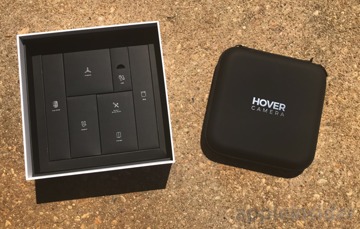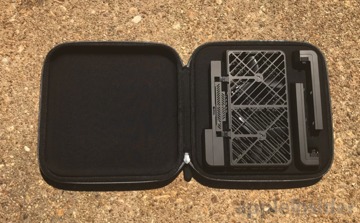Despite online documentation support and instructions charitably described as a nightmare, the Hover Camera Passport is a good solution for most -- but only time, and usage tells the tale.

The Hover Camera Passport shipped at the end of 2016 for $599 as an Apple Store exclusive and promised to be a gateway for easy drone photography -- a flying "selfie stick," as it were, and available only from Apple. The hardware has since dropped to $499, and remains as an Apple Store exclusive and is featured prominently in some Apple Retail point-of-purchase displays.
There's a reason why Apple stocks it. The Hover Camera Passport is solidly designed, with the box designed to be a storage bunker for accessories and components for the drone. A zipper case holds the drone itself and the two batteries that ship with the unit.
The batteries change from empty to full in the provided charger in about an hour.

The drone is controlled through an iPhone app, and connects through a private wi-fi network generated by the drone itself. A tutorial in the app takes the user through the basic features of the drone, but neglects one crucial step -- a firmware update check.
If you've got one built recently, this is probably fine. If you've got stock that's been sitting around for a while, not so much.
The drone that was supplied to AppleInsider had ridiculously outdated firmware, and as such, during the early tutorials, the drone wouldn't return and was out of reach.
Exacerbating the problem, advanced features like manual control and the automated emergency landing command aren't available until the tutorials which include launching the drone are complete. So, we were in a position where the drone hadn't locked on to us, and gesture controls weren't being recognized.
As a result, the drone drifted away and climbed about 20 feet away from us, perilously close to a roof sounding like an angry bee swarm the entire time.
Fortunately, in a low-power situation, the drone uses it's downward-pointing camera to gently land, so we just waited out the battery, and got lucky with the roof proximity.
We've since completed the tutorial, and have updated the firmware on the drone. This still isn't the best situation, and should be done in an area with the best possible LTE signal -- as there is no restarting a failed download.
Since the firmware update crisis, we've had a better time with the drone. Maximum range is said to be about 35 feet from the controlling phone, but we didn't lose communication to the drone until closer to 75 feet.
Actual flight
After initial operational and connectivity testing, we doled out the drone to relations more photogenic and better pilots than us.
The assorted lock-on features and flight modes worked fine. Still images were full of color, and clear.
However, when shooting video the drone is -- for lack of a better term -- jittery, and this is clear when you look at what you shot. Don't cut resolution down to 1080p and hope for better -- because you won't get it. Stick with 4K and apply image stabilization in video editing tools.
The video below won't expand into 4K when embedded in Safari. Click through to YouTube for 4K options.
Beware of weather
Drones aren't planes, and are more akin to helicopters. As such, behavior in weather varies widely based on the geometry of the device.
The Hover Camera Passport has many right angles that cross-winds can grab. In the range-testing process, we flew the drone up the side of a sound-retaining wall -- and immediately hit brutal drafts from the highway traffic when we crested the top.
Using a heavier and more aerodynamic DJI Phantom 3, we didn't have much in the way of buffeting from the highway. However, the Hover Camera Passport struggled with the updrafts from the traffic.
Fortunately, we didn't lose all control, and the app continued to communicate with the drone fine even while being tossed about. We managed to get it back, and stability was regained when we dropped below the level of the wall.
Battery life alters use cases
A drone is only as good as an airborne platform if it can stay aloft. The Hover Camera Passport has a maximum flight time of 9 minutes and 12 seconds in our static hover test, and 7 minutes and 41 seconds when filming.
The DJI Phantom 3 that we were using for comparative testing lasted for around 22 minutes, with an inferior camera.
But, the Phantom 3 is bigger and heavier. Its less able to be tossed in a bag, and deployed at a moment's notice than the Hover Camera Passport is.
However -- there's a new challenger. The DJI Spark also retails for $499. We're still looking at that one, but on paper edges out the Hover Camera Passport in flight time, speed, and range from the controlling app.
Score: 3 out of 5
If the support assets for the drone are cleaned up, including how to perform a manual firmware update from macOS without flipping through four different support pages, this will go up an extra half point. We'll keep our eyes peeled.
Beyond the score
Tech is hard to quantify with a number. There's no universal scale of compatibility with every given use case.
If you're flying a drone just to fly, then the Hover Camera Passport is not for you, and it's a 2 out of 5. It doesn't stay aloft long enough, and flying it in any kind of weather is rough.
But, If you're taking a hike or something, it can be an effort to haul around a drone with a long flight time like the Phantom 3. The case for the Hover Camera Passport can be easily crammed in a backpack or day-bag and brought along without much regard for support equipment or a hard case -- in this case, the drone is a solid 4 out of 5.
Where to buy
The Hover Camera Passport is available exclusively at Apple for $499.95 with free 2-day shipping. For deals on other drone alternatives, including DJI's line of quadcopters, please visit our Drone Price Guide.




